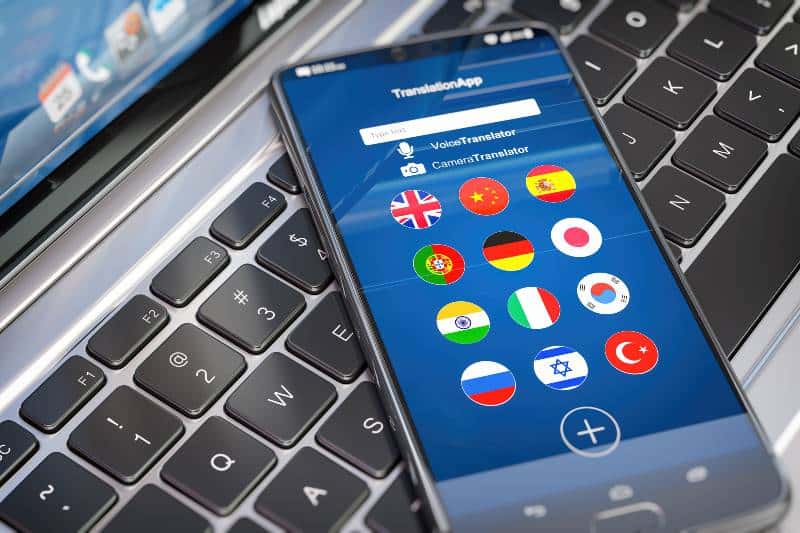Are you wanting to grow your business and reach more customers? Consider taking advantage of the benefits of multilingual SEO! and This is an effective way of helping your multilingual website rank higher in search engine results, as well as increasing visibility for potential customers who don’t speak English. In this post, we will discuss the steps necessary to set up a successful multilingual SEO campaign and how it can help you stay ahead of the competition! Keep reading to learn how to become an expert at international SEO.
Multilingual SEO involves translating your website content into a multilingual website, enabling users who search Google in specific languages to discover your website in organic search results. This practice enhances the quality of your writing, and improves word choice, structure, readability, and eloquence while preserving the original meaning.
Key Takeaways
- Multilingual SEO opens doors to vast global markets, allowing businesses to engage with diverse audiences in their native languages.
- While there are hurdles in implementing multilingual SEO, such as cultural nuances and technical SEO adjustments, the rewards in terms of global reach and engagement are significant.
- Successful multilingual SEO requires more than just translation; it calls for cultural sensitivity, the right tools, and consistent strategy implementation.

Why is Multilingual SEO Important?
In today’s digital age, where businesses aim to reach a global audience and online markets are more diverse than ever, Multilingual SEO (Search Engine Optimization) has become paramount. Understanding its importance necessitates an exploration of the underlying factors driving its demand:
Growth of Non-English Speaking Online Users
Over the past few years, there’s been a significant surge in the number of non-English speaking internet users. For instance, while English remains a dominant language online, languages such as Mandarin, Spanish, Arabic, and Hindi have seen an exponential growth in users. Imagine a local shop in Spain. If they have a website exclusively in English, they’re inadvertently ignoring a vast majority of their potential local audience who might search online in Spanish. The web is global, but local cultures and languages influence the way users search, shop, and interact online.
The Demand for Localized Content
Just as people prefer to shop in stores where they can speak their native language, online users are more likely to interact with and trust websites that ‘speak’ their language. Studies suggest that consumers are significantly more likely to purchase products online when information is presented in their native tongue. Let’s consider a French speaker looking to buy a novel online. If they land on a site that has reviews, summaries, and recommendations all in fluent French, rather than poorly translated or exclusively in English, they are more likely to make a purchase. This illustrates the sheer power and potential of localized content in driving online conversions.
Opportunities in Emerging Markets
As businesses seek expansion, emerging markets present lucrative opportunities. Countries like India, Brazil, and many in Africa are experiencing rapid growth in internet penetration. However, these are not monolingual markets.
In India, for example, while a significant portion of the urban population might be comfortable with English, there are 22 recognized languages and a myriad of dialects spoken throughout the country.
Therefore, if a company is selling a tech gadget and optimizes its online content only for English-speaking Indians, it’s missing out on reaching a broader audience that might be searching in Hindi, Bengali, Telugu, or any of the other prevalent languages.
Multilingual SEO is more than just a strategy to improve search rankings in different languages. It’s about understanding and respecting cultural nuances, optimizing for local search habits, and providing content that resonates with a diverse audience. By acknowledging the linguistic and cultural diversity of the internet’s user base, businesses can truly harness the power of the global market.
Whether you’re a small local business or a large multinational corporation, the potential to grow and connect more deeply with your audience through multilingual optimization is immense. Adopting such strategies not only augments your digital footprint but also builds trust and inclusivity in an increasingly interconnected world.
Challenges of Multilingual SEO
Multilingual SEO, while offering a plethora of opportunities, also presents several challenges. As businesses strive to cater to a global audience, they must confront and navigate the intricacies of different languages, cultures, and the technicalities of presenting their content to various regions. Here’s a deeper dive into some of the predominant challenges:
Dealing with Translations and Cultural Nuances
One of the biggest challenges in Multilingual SEO is ensuring that content isn’t just translated, but also localized. A direct translation of content might not necessarily resonate with the target audience due to cultural differences.
For instance, a marketing slogan that’s catchy in English might lose its appeal or even convey an unintended message when directly translated into another language.
A popular example is KFC’s slogan “Finger-lickin’ good” which, when initially translated for the Chinese market, reportedly read as “Eat your fingers off.” Thus, businesses need to invest in professional translation and localization services to ensure content is both linguistically correct and culturally appropriate.
Technical SEO for Multiple Languages
When it comes to setting up a website that serves content in multiple languages, there are numerous technical aspects to consider. This includes setting up hreflang tags to indicate to search engines which language you are using on a specific page, ensuring the correct language version of a page is shown to users in search results.
Moreover, there’s the challenge of deciding between using subdomains, subdirectories, or completely separate domains for different languages. Each has its advantages and drawbacks in terms of SEO, user experience, and maintenance. Then there’s the matter of avoiding duplicate content across different language versions, which can lead search engines to penalize your site.
Maintaining Consistency Across Different Regions
Even as you adapt your website for different languages and cultures, maintaining a consistent brand message and user experience across all regions is crucial. This is challenging because while you want to localize content, you also don’t want a user from Spain to have a drastically different perception or experience of your brand compared to a user from Japan.
This challenge extends not just to content, but also to design elements, site navigation, and even calls to action. For example, color psychology varies across cultures; a color that’s considered lucky or positive in one culture might be viewed negatively in another. Thus, brands must strike a delicate balance between localization and global brand consistency.
Multilingual SEO is a multifaceted discipline that demands a keen understanding of linguistic nuances, sharp technical acumen, and a strategic approach to brand consistency. Overcoming these challenges requires collaboration between SEO experts, cultural consultants, and technical teams to ensure a seamless and effective online presence across multiple languages and regions.
Benefits of Multilingual SEO
Multilingual SEO isn’t just a trend; it’s a strategic approach to global digital marketing that brings along a multitude of benefits. Tapping into diverse linguistic markets, businesses can unlock new levels of online engagement and brand recognition. Let’s explore these benefits in detail:
Increased Global Reach
Perhaps the most straightforward benefit, optimizing your content for multiple languages means that your website becomes accessible and relevant to a broader audience. For instance, while a monolingual English website might appeal largely to audiences in countries like the US, UK, and Australia, adding versions in Mandarin, Spanish, or Arabic immediately opens up enormous markets in China, Latin America, and the Middle East, respectively.
To give this a tangible perspective, imagine a software solution company offering its products globally. If its website and content cater only to English speakers, it would miss out on potential customers in countries like Germany, Japan, or Brazil, where local languages dominate online searches.
Higher Engagement with Local Audiences
Localized content isn’t just about speaking the language; it’s about resonating with the local audience’s cultural context, values, and needs. When users find content that’s both in their language and tailored to their cultural nuances, they are more likely to engage, trust, and convert.
For instance, an e-commerce website selling beauty products will find higher engagement rates in South Korea if they offer content in Korean discussing local beauty trends, rather than just a translated version of their English content. It’s this nuanced understanding and catering to local preferences that lead to more extended site visits, lower bounce rates, and, ultimately, more conversions.
Enhanced Brand Image and Trustworthiness
Offering content in multiple languages conveys a message that a brand is global, inclusive, and customer-centric. It shows a commitment to serving diverse communities and respecting their languages and cultures. Consider a user in France stumbling upon a tech website that offers detailed product information in fluent French versus another that only has an English version.
The former not only makes it easier for the user to understand the offering but also instills a sense of trust and relatability. The brand is perceived as more credible and reliable, having made the effort to communicate in the user’s native language.
Best Practices for Implementing Multilingual SEO
Implementing Multilingual SEO is a meticulous process that requires an amalgamation of linguistic expertise, technical knowledge, and strategic foresight. To ensure your efforts yield the desired results and you truly cater to your diverse audience, here are some best practices to keep in mind:
Keyword Research for Each Language
It’s not enough to simply translate your English keywords into other languages. Linguistic nuances, local jargon, and cultural contexts can greatly influence how people search in their native languages. For instance, while “smartphone” might be a popular keyword in English, Spanish users might more commonly search for “teléfono inteligente” or just “móvil”. Therefore, thorough keyword research tailored for each language is imperative. Utilize tools like Google’s Keyword Planner, SEMrush, or Ahrefs, and consider local search engines or tools specific to the region, to get an accurate sense of what your target audience is searching for.
Importance of Quality Translations
Simply relying on automated tools like Google Translate for website content can be a grave mistake. Such translations often miss idiomatic expressions, cultural references, and subtle language nuances. Instead, invest in professional translation services or native speakers who can also provide cultural insights. Remember, localization goes beyond mere translation. For example, while translating content for a Japanese audience, understanding the country’s business etiquette, cultural nuances, and preferred formalities can make your content more relatable and effective.
Utilizing hreflang Tags (url structure)
The hreflang tag is an HTML attribute that signals to search engines the language and geographical targeting of a page. It helps ensure that the right language version of your website appears in search results for a particular audience. For instance, if you have English, Spanish, and French versions of your website, hreflang tags can help ensure that users in Mexico see the Spanish version, Canadians in Quebec see the French version, and US users see the English version. When implementing hreflang tags:
Ensure they’re correctly placed in the HTTP header, site map, or on-page markup.
Use the correct language and country codes. For example, “es-MX” for Spanish as used in Mexico and “en-US” for English as used in the United States.
Double-check for errors. Incorrect implementation can lead to the wrong version being displayed or even SEO penalties.
It’s best to get the help of a multilingual SEO agency to ensure you get this right! Adding hreflang attributes is also important for multi-regional websites in the same language, but are slightly different for various regions.
In addition to these core best practices, it’s also crucial to maintain a consistent site structure, consider the technical aspects of domain strategy (whether you choose subdomains, subdirectories, or separate domains for each language), and regularly monitor and optimize based on performance analytics specific to each language version.
Incorporating Multilingual SEO is a strategic decision that, when executed with attention to detail and best practices, can significantly elevate a brand’s global online presence, reach, and engagement.
Case Studies
The power of multilingual SEO can be best illustrated through real-world examples. Here are a couple of brands that have successfully tapped into the benefits of optimizing for multiple languages, along with the tangible outcomes they achieved:
Airbnb:
- Implementation: Airbnb, the global online marketplace for lodging and travel experiences, recognized the importance of catering to a global audience early on. They embarked on an ambitious project to translate their website and listings into dozens of languages. But beyond just translation, Airbnb localized content, imagery, and even pricing to align with regional preferences and cultural nuances.
- Benefits and ROI: This localization strategy, backed by robust multilingual SEO, allowed Airbnb to gain a foothold in non-English speaking markets rapidly. As a result, they saw a significant increase in listings and bookings from regions like Europe, Asia, and South America. For instance, in certain markets like France and Japan, they reported over 10x growth in user engagement after localization efforts. This not only increased their global user base but also solidified their position as a truly international brand.
Zalando:
- Implementation: Zalando, a leading European online fashion retailer, embarked on a comprehensive multilingual SEO strategy to cater to the diverse European market. They created dedicated websites for different countries, ensuring not just language translations but also tailoring content to regional fashion trends, sizes, and seasonal demands.
- Benefits and ROI: Zalando’s meticulous approach to multilingual SEO was instrumental in its rise as a dominant online fashion player in Europe. Their region-specific websites consistently ranked at the top for popular fashion-related searches in respective languages. This led to a spike in organic traffic, reduced bounce rates, and higher conversion rates. Their commitment to localization also enhanced brand trust and loyalty among local consumers.
Neil Patel (Digital Marketing Expert):
- Implementation: While not a brand in the traditional sense, Neil Patel’s decision to translate his marketing blog into multiple languages offers valuable insights. Recognizing the demand for quality digital marketing content beyond the English-speaking audience, Neil and his team decided to offer his content in languages like Spanish, Portuguese, and German. They ensured high-quality translations and optimized for popular search terms in each language.
- Benefits and ROI: The results were astounding. Neil reported that the Portuguese version of his site started to attract more traffic than the English one, with the Spanish version not far behind. This not only amplified his global readership but also expanded his clientele for his digital marketing services.
These case studies underscore the potential of multilingual SEO. When implemented effectively, it can dramatically boost a brand’s global footprint, engage diverse audiences, and significantly enhance return on investment. This article can help you improve even more! It’s all about the Importance of SEO in Driving Inbound Marketing Results this can help you with your SEO efforts for multilingual audiences. Be sure to check it out!

Multilingual SEO FAQs
How can a company ensure its content is culturally appropriate for different regions?
The key to delivering culturally appropriate content is to invest in professional translation services or native speakers who can also provide cultural insights. Remember, localization goes beyond mere translation. For example, while translating content for a Japanese audience, understanding the country’s business etiquette, cultural nuances, and preferred formalities can make your content more relatable and effective.
Can’t I just use automated translations for my website?
While automated translations such as Google Translate have come a long way, they still produce clunky and often inaccurate results. This can lead to confusion among readers and even damage your brand’s reputation. It is always best to opt for professional translation services for multilingual websites.
How do search engines handle multiple languages?
Search engines such as Google search will recognize the language of a particular page and prioritize it accordingly in search results. This means that when someone searches for something in Spanish, for instance, all the pages indexed by Google with Spanish content language will be ranked higher than those in other languages.
What is the significance of the hreflang tag in multilingual SEO?
The hreflang tag is an HTML attribute that helps search engines identify the language and regional variations of a page. It ensures that readers in different regions are shown the correct version of your website, indexed for their local language. This enhances user experience and can greatly improve SEO performance.
How can I track the success of my multilingual SEO efforts?
The best way to track the success of multilingual SEO is to monitor metrics such as organic traffic, conversions, and time spent on pages in different languages. Using web analytics tools like Google Analytics can provide valuable insights into how each language version of your website is performing. This will help you identify gaps and take necessary corrective measures for continual optimization.
Conclusion
A multilingual SEO strategy is a powerful way to extend your business’s reach to entirely new regions and engage with potential customers around the world.
However, localizing your content needs careful planning to avoid cultural misunderstandings or ineffective technical SEO practices. By investing in the right tools, hiring experienced staff members for translation and optimization tasks, and fostering an attitude of sensitivity across all markets, you can effectively compete in multiple languages.
If you’re looking to expand the reach of your business, why not consider multilingual SEO? And if you’re not sure where to start, contact us today – we would love to chat during our free strategy call and help you figure out how best to approach it!






